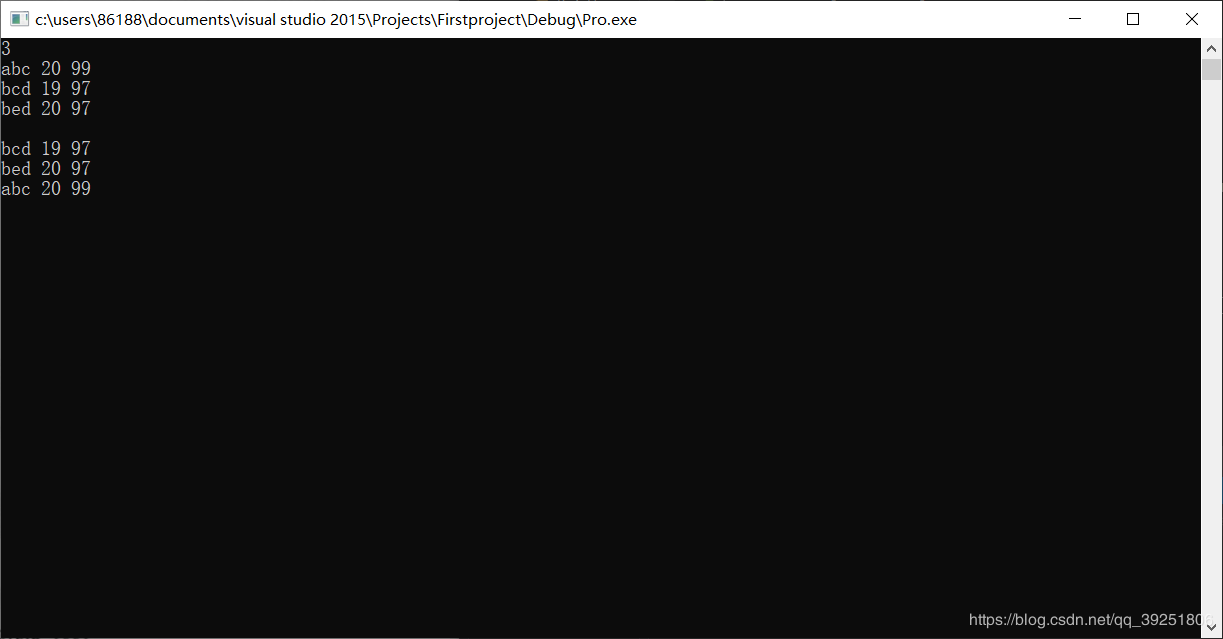sort函数用于C++中,对给定区间所有元素进行排序,默认为升序,也可进行降序排序。sort函数进行排序的时间复杂度为n*log2n,比冒泡之类的排序算法效率要高,sort函数包含在头文件为#include<algorithm>的c++标准库中。
题目描述:
有N个学生的数据,将学生数据按成绩高低排序,如果成绩相同则按姓名字符的字母排序,如果姓名的字母序也相同,则按照学生的年龄排序,并输出N个学生排序后的信息。
#include<stdio.h>
#include<algorithm>
#include<string.h>
using namespace std;
struct E {
char name[101];
int age;
int score;
}buf[1000];
bool cmp(E a, E b) {
if (a.score != b.score) return a.score < b.score;
int tmp = strcmp(a.name, b.name);
if (tmp != 0) return tmp < 0;
else return a.age < b.age;
}
int main() {
int n;
while (scanf_s("%d", &n) != EOF) {
for (int i = 0; i < n; i++) {
scanf_s("%s%d%d", buf[i].name,sizeof(buf[i].name), &buf[i].age, &buf[i].score);
}
sort(buf, buf + n, cmp);
printf("\n");
for (int i = 0; i < n; i++) {
printf("%s %d %d\n", buf[i].name, buf[i].age, buf[i].score);
}
}
return 0;
}
注意事项
scanf和scanf_s区别使用,scanf_s需要标明缓冲区的大小,因而多出一个参数。 Unlike scanf and wscanf, scanf_s and wscanf_s require you to specify buffer sizes for some parameters. Specify the sizes for all c, C, s, S, or string control set [] parameters. The buffer size in characters is passed as an additional parameter. It immediately follows the pointer to the buffer or variable. For example, if you're reading a string, the buffer size for that string is passed as follows:
char s[10];
scanf_s("%9s", s, (unsigned)_countof(s)); // buffer size is 10, width specification is 9
微软参考文档
结果

通过运算符重载来实现
#include<stdio.h>
#include<algorithm>
#include<string.h>
using namespace std;
struct E {
char name[101];
int age;
int score;
bool operator <(const E &b) const {
if (score != b.score) return score < b.score;
int tmp = strcmp(name, b.name);
if (tmp != 0) return tmp < 0;
else return age < b.age;
}
}buf[1000];
int main() {
int n;
while (scanf_s("%d", &n) != EOF) {
for (int i = 0; i < n; i++) {
scanf_s("%s%d%d", buf[i].name,sizeof(buf[i].name), &buf[i].age, &buf[i].score);
}
sort(buf, buf + n);
printf("\n");
for (int i = 0; i < n; i++) {
printf("%s %d %d\n", buf[i].name, buf[i].age, buf[i].score);
}
}
return 0;
}
由于已经指明了结构体的小于运算符,计算机便知道了该结构体的定序规则。 sort函数只利用小于运算符来定序,小者在前。于是,我们在调用sort时便不必特别指明排序规则(即不使用第三个参数)。
总结
到此这篇关于通过c++的sort函数实现成绩排序的文章就介绍到这了,更多相关c++ sort函数内容请搜素自由互联以前的文章或下面相关文章,希望大家以后多多支持自由互联!
